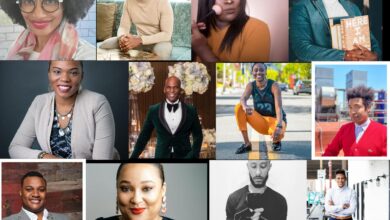How To Realistically Cultivate Creativity

Paula-Bartosiewicz
Allen Gannett is the founder and CEO of TrackMaven, an analytics software used by marketers at Microsoft, Home Depot, Saks Fifth Avenue and GE. He’s also been included on the “30 Under 30″ list for both Forbes and Inc.
He’s recentely published his first book, The Creative Curve: How to Develop the Right Idea, at the Right Time, which demystifies the concept of creativity into a predictable science that anyone can tap into to achieve their version of success.
I spoke with Allen about why he thinks it’s important for creatives to imitate the work of leaders in their field, what sources of data are the most important to validate a creative’s ideas and what impact being gay has had on his creativity.
This interview has been edited and condensed for clarity.
Brian Honigman: Why do most people believe that creative success comes down to having a light bulb moment or that it’s reserved for geniuses?
Allen Gannett: Our culture has a reverence for story. We have a lot of love for the hero story and the hero myth. What you see is that the popular media, whether that’s books, magazines or movies, tend to take these people and canonize them. That’s how we sort of internalize creativity and the concept.
Like in the movie Amadeus, for example, which portrays Mozart woefully incorrectly. But that’s how most people internalize Mozart, as this kid who at three-years-old was playing the piano blindfolded for the pope.
That’s not actually true. In fact, Mozart is a famous example as there was a letter written by him where he claimed to have the rough drafts of his music compositions in his head. It was found out later that that letter was actually forged by a music magazine publisher who wanted to sell copies.
Creativity has been one of the go-to things that we’ve canonized among individuals. And the concept of creativity and the reality of creativity are very different now.
Honigman: You’ve identified that many of the world’s most creative minds wholeheartedly embraced imitation as part of their approach to commercial success. What’s the right way of imitating the work of others in a field?
Gannett: One of the things that people make a mistake of when it comes to creativity is they over focus on the novelty part. Scientists have found that creatives find the most success when they create ideas that are a blend of the familiar and the novel. Those are the ideas that we tend to be most attracted to.
It’s like how the original Star Wars was a western in space. As a result you have to be able to create things that are also familiar. One of the best ways to do that is to imitate, not the content or the sort of holistic stuff of other great creatives, but actually imitate the structure like turning creative works into Mad Libs.
We see this really well in pop music. Like the recurring themes in the way pop music is written right now as the last 20 years has been the Swedish era of pop songwriting. They follow very similar patterns and structures. The way to learn how to become a pop singer or a pop songwriter is not to just start hemming at the piano. It’s actually to experience other people’s content in an imitative way where you’re actually going through and figuring out what the structure of it is.
Kurt Vonnegut at one point tried to get a master’s thesis in anthropology, and for his master’s thesis what he did is he mapped out the emotional arc of stories to identify the recurring themes, and using that is how he sort of figured out that there’s four recurring patterns of story arcs. That was a foundational experience for him becoming a creative as he was able to see what structures already existed.
You don’t have to re-invent the wheel. If you want to be creative, you don’t have to re-invent the structure. It’s about reinventing that little bit of novelty that makes something new and intriguing.
Honigman: Many of your recommendations for achieving creative success rely on collecting and analyzing data. With more options to reference than ever, how can a professional figure out what sources of data are worth paying attention to?
Gannett: These days, the right data is all about listening to your audience. In the book I talk about Ben & Jerry’s flavor R&D team, which used a relatively low-fi approach. What they did is they literally just sent email surveys to their customers about new flavor ideas and that’s how they developed an understanding of whether an idea would be too familiar or too novel. That’s the sweet spot of commercial viability and uniqueness to be interesting.
Surveying your customers is one of the most essential and the most underused technique. You see this across all sorts of creative industries, like how movies do test screenings. I think a lot of aspiring creatives under-appreciate the value of iteration and feedback. It’s really, really important to incorporate that in your process. It doesn’t have to be high-tech. We’re not talking about big data, it just has to be data.
Honigman: In hindsight, what patterns can you identify in your own career that have helped lead to your success as an entrepreneur at such an early age?
Gannett: For me I think the progress– I’ll use that word. The progress I’ve made so far has been really focused on having smart, experienced people who are in my orbit and play a big role in giving me advice and feedback and lend me their reputation and credibility, all that kind of stuff.
Relationships are a critical and essential part of the creative process. Nowadays and even eight years ago, I’ve always been really focused on meeting people and bringing them into my orbit. And I think that’s been a really big part of my progress to date.
Honigman: How has being a gay business leader provided an additional source of creativity for your career?
Gannett: Being gay has a bunch of interesting impacts when it comes to creativity. One is you are exposed to different types of ideas. There’s a lot of studies that show that the people or teams who tend to be the most successful straddle both a mainstream reputation but who also have access to fresh ideas from the fringe. Having access to a different set of ideas than what’s going on in the mainstream is really useful for getting a sense of culture before it’s permeating out to other places.
Honigman: How can LGBTQ entrepreneurs add creativity to their approach to business?
Gannett: One of the things I talk about in the book is that creativity really is a social construct and a social phenomenon as you need other people in order to be creative. Your ideas need to be distributed for people to assess them and view them.
Traditionally there’s been a lot of structural issues. Creative fields are some of the least diverse, even though you’d think they’d be very diverse because the sort of social element in creative fields is so valuable. If you’re an aspiring writer, having a really talented agent, being mentored by a previous agent is so important or if you’re a young producer, having an older producer who’s sort of apprenticing you is such a critical part of creative fields.
Also creative industries tend not to need to recruit because so many people apply and they tend to have a lot of internships. People from disadvantaged communities often can’t take on an internship because they can’t afford to work for free or for a low wage.
Creative industries actually have a lot of institutional barriers for diverse communities, whether you’re a women, person of color or LGBTQ. If you’re part of any diverse community it is important to be aware of that and know that you might have to push a little bit harder.
Studies show that we do like to mentor people who are like us and similar to us, and a lot of the people who are in power and have resources aren’t gay. You have to be aware of that and conscious of that. Luckily, that’s becoming less and less of an issue especially in major cities, but it is still an issue.
Follow me on Twitter or LinkedIn. Check out my website.





